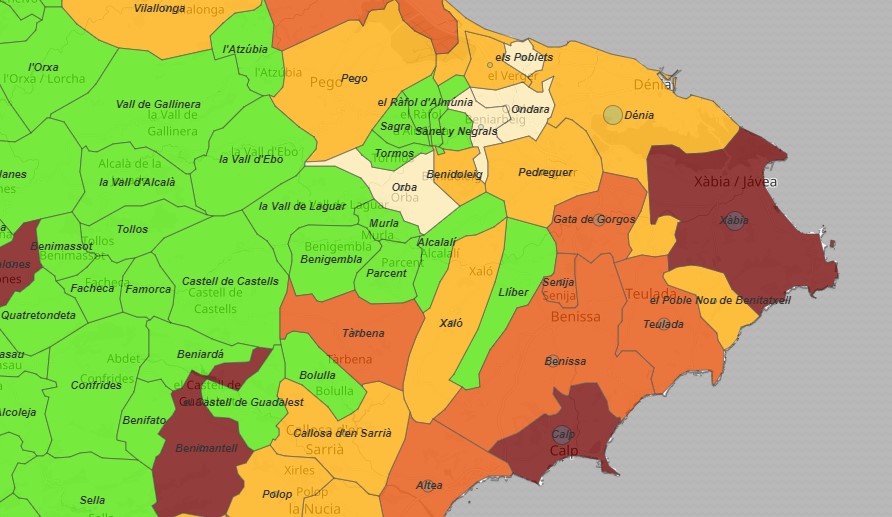VIRUS UPDATE: Xàbia moves into ‘Very High Risk’ category after surge in positive cases
The Generalitat Valenciana has decreed additional measures in order to combat the spectacular rise in cases among young people which will come into force at midnight tonight.

Friday 9th July 2021 – Compiled by MIKE SMITH
The total number of positive coronavirus cases detected by PCR test in Xàbia has climbed to 1,585, according to the latest update from the regional health ministry. The number of cases detected in the past 14 days stands at 73 cases, which means that the municipality’s 14-day IA rate, a measure of the speed at which the virus moves through the population, has soared to to 260.57 cases per 100,000 inhabitants, the highest it has been since Valentine’s Day, and the town is now in the ‘Very High Risk’ alert level. There have been no new deaths in Xàbia since late March and the number remains at 12.
In the Marina Alta region, there have been 285 new positive cases detected in the past 14 days whilst the total number of positive cases since the pandemic began has been confirmed as 10,494 since the last update, a rise of 120:
- 30 – Calp; Xàbia
- 28 – Dénia
- 7 – Teulada
- 6 – El Vergel
- 4 – Pego
- 3 – Benissa; Gata de Gorgos
- 2 – Ondara; Poble Nou de Benitatxell
- 1 – Benidoleig; Els Poblets; Orba; Pedreguer; Senija
The region’s 14-day IA rate has risen to 165.86 cases per 100,000 inhabitants – five times higher than it was two weeks ago – and the region is now in the ‘High Risk’ category. There have been no new deaths since the last update and the region’s toll remains 203.
In terms of infection spread, Calp heads the table with 278.66 new cases per 100,000 inhabitants over the past 14 days. It is joined in the ‘Very High Risk’ category by Xàbia (260.57). Four municipalities are now at the ‘High Risk’ level: Gata de Gorgos (224.25), Teulada (212.80), Senija (171.53) and Benissa (150.60) whilst seven are in the ‘Medium Risk’ category, including Dénia (135.43) and Poble Nou de Benitatxell (134.77). Four towns are at the ‘Low Risk’ level whilst there are now just 16 municipalities in the Marina Alta at the ‘New Normal’ level, mainly inland rural communities.
Spain
Spain’s 14-day IA rate is 277.16 cases per 100,000 inhabitants and the country has climbed back into ‘Very High Risk’ category for the first time since February 22nd. The rate has been rising quickly for almost two weeks and is around three times higher than it was a fortnight ago. The numbers are clearly showing that the infection spread is being accelerated by the younger population who have not yet been vaccinated; the 20-29 age group has a 14-day IA rate of 911.23, more than three times higher than the national average, and only 11.0% of that age group have been fully immunized. This week, Valencian president Ximo Puig announced that vaccination for young people in this group has been brought forward to the beginning of August.
Consequently, the Positivity Rate, the measure of how many coronavirus tests return positive, has risen to 10.08%, more than double the value it was two weeks ago. A value of 5% or less indicates that transmission of the virus is more or less under control.
Cases might be soaring but the pressure on the hospital system is currently not increasing; 2.42% of beds in general wards occupied by patients being treated for COVID-19, about 25% more than two weeks ago, whilst 6.64% of ICU beds are occupied by such patients, a decrease of around 6.0% on two weeks ago. Be aware, however, that this is the nature of the virus; cases increase, then hospitalization increase, then deaths increase. Hopefully, the acceleration of the vaccination campaign nationally will not see great increases in the latter two phases.
Across Spain, all 19 autonomous communities and cities has seen positives cases rise over the past two weeks with the Comunidad Valenciana particularly suffering a surge in infection spread and its rate is currently more than six times higher than two weeks ago, which is the fastest rise of any region.
Link: Valencia announces tightening of measures as virus spread accelerates
Cataluña leads the way with a general IA rate of 602.67 cases per 100,000 population over the past 14 days. With regards to age groups, the 20-29 year old IA rate has soared to a whopping 2,165.69 cases per 100,000, by far the highest rate in the country; by comparison, the Comunidad Valenciana is well behind with 850.76. As a consequence, the Catalan regional government is closing all indoor nightlife venues from today for at least 16 days and calling the Central Government to make the use of masks outdoors mandatory again.
Elsewhere, Castilla y León was planning to request that the Central Government to re-introduce a night curfew running between 1.00am and 6.00am and said it would consider imposing the measure itself if the request was denied whilst Madrid has ruled out introducing any new measures, preferring to work on raising awareness among young people and also offering anyone over 25 the chance to book their first vaccine jab from today.
The newspaper El País has reported that some public health experts have suggested that the virus should be allowed to spread uncontrolled, citing the UK’s decision to lift most if not all of its coronavirus restrictions from July 19th on the basis that 50% of the population is now fully vaccinated and that there is a low risk for young people. However, the medical journal The Lancet argued against this approach, citing that more than 17 million people in the UK still won’t have any protection against COVID-19 when the measures are relaxed and, given the high transmission rate of the Delta variant, there are risks that a whole generation will be left with chronic health problems and disabilities which will have a personal and economic impacts for decades to come.
Note: The UK’s 14-day IA rate is currently 484.7 cases per 100,000 inhabitants, almost twice that of Spain.
Vaccination (08.07.21)
Spain has administered 45,924,484 doses of vaccine, which is 89.5% of those which it has already received. A total of 20,528,505 people have completed the recommended course, which is 48.7% of the total of the population which is to be vaccinated (40,129,822).
According to the latest data provided by the health authorities, 89.2% of people aged 40 and over in Spain have received at least one dose, with 70.6% having completed the recommended course.
The Comunidad Valenciana has administered 4,671,818 doses of vaccine, which is 89.0% of the total which it has received. A total of 2,104,992 people have completed the recommended course, which 46.9% of the population which is to be vaccinated (4,289,305).
According to the latest data provided by the health authorities, 88.3% of people aged 40 and over in the Comunidad Valenciana have received at least one dose, with 68.6% having completed the recommended course.
LINKS
- Actualización nº 414. Enfermedad por el coronavirus (COVID-19). 08.07.2021
- GIV COVID-19 Gestión integral de la vacunación COVID-19
- COVID-19 C. Valenciana: Monitoratge de la situació



